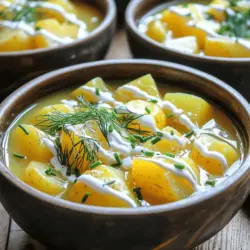Introduction
In the heart of Polish cuisine, soups hold a special place, serving not just as a meal but as a comforting embrace on chilly days. From the rich flavors of barszcz to the nourishing warmth of żurek, each soup tells a story steeped in tradition and culture. Among these, Kartoflanka stands out as a quintessential dish that resonates deeply with the Polish spirit. This hearty potato soup, brimming with rustic flavors, is much more than a simple recipe; it embodies the essence of Polish home cooking, where warmth and comfort take center stage.
Kartoflanka is traditionally made with potatoes, a staple in Polish kitchens, and is known for its simplicity and accessibility. Its ingredients are often found in the pantries of many households, making it an ideal dish for both novice cooks and seasoned chefs alike. The beauty of Kartoflanka lies in its ability to transform humble ingredients into a satisfying meal that warms the heart and soul. As you explore this classic recipe, you’ll discover how the combination of textures and flavors creates a comforting bowl of goodness that can be enjoyed any time of the year.
Understanding Kartoflanka
Historical Context of Potato Soup in Poland
Potatoes have been a cornerstone of Polish agriculture and cuisine since they were introduced to Europe in the late 18th century. They quickly became a staple food due to their versatility and ability to thrive in the Polish climate. Over the years, potatoes have been incorporated into various traditional dishes, with Kartoflanka emerging as a beloved comfort food. Historically, this soup was a practical way to use up leftover vegetables and provide sustenance to families, reflecting the resourcefulness of Polish cooks.
Different regions of Poland have their own interpretations of Kartoflanka, influenced by local ingredients and culinary traditions. In some areas, it is made with a creamy base, while others prefer a brothier version. Regardless of the variation, the essence of Kartoflanka remains the same: a nourishing soup that showcases the humble potato.
Nutritional Benefits of the Main Ingredients
Kartoflanka not only delights the palate but also offers a range of nutritional benefits. The primary ingredient, potatoes, is an excellent source of carbohydrates, providing energy and helping to keep you feeling full. They are also rich in vitamins such as vitamin C, which supports the immune system, and potassium, which is vital for heart health.
Onions and garlic, often used in the base of the soup, contribute additional health benefits. Onions are known for their anti-inflammatory properties and can help improve heart health, while garlic boasts numerous health benefits, including immune support and potential anti-cancer properties. By combining these wholesome ingredients, Kartoflanka becomes a nourishing meal that not only satisfies hunger but also supports overall well-being.
The Role of Potatoes in Polish Culinary Traditions
In Polish culinary traditions, potatoes are revered not just for their nutritional value but also for their adaptability. They can be prepared in countless ways, from mashed to roasted, and play a vital role in many iconic dishes, such as pierogi and placki ziemniaczane (potato pancakes). The love for potatoes is reflected in Kartoflanka, where they serve as the star ingredient, creating a creamy, velvety texture that makes the soup irresistibly comforting.
Ingredients Breakdown
To prepare a delicious pot of Kartoflanka, you’ll need a handful of simple yet flavorful ingredients. Each component plays a significant role in building the soup’s character and depth of flavor.
Potatoes: Types and Their Culinary Uses
The foundation of Kartoflanka is, of course, the potatoes. When selecting potatoes for this soup, it’s best to choose waxy varieties such as Yukon Gold or red potatoes. These types hold their shape well during cooking and contribute a creamy texture to the soup when mashed or blended.
For a more traditional approach, some regions may use starchy potatoes like Russets, which break down more easily and create a thicker consistency. Regardless of the type you choose, potatoes are essential for creating the heartiness that defines Kartoflanka.
Onions: Importance in Flavor Building
Onions are a must-have in any savory dish, and Kartoflanka is no exception. Their natural sweetness adds depth to the soup and balances the earthiness of the potatoes. Sautéing onions until they are translucent and fragrant is a crucial first step in building layers of flavor. The aromatic base they create serves as the perfect backdrop for the other ingredients, enhancing the overall taste of the dish.
Garlic: Health Benefits and Flavor Enhancement
Garlic is another key player in Kartoflanka, contributing both flavor and health benefits. Its distinctive aroma and taste elevate the soup, providing a savory kick that complements the creamy potatoes. Garlic is known for its antimicrobial properties and potential health benefits, making it a valuable addition to your diet. For this recipe, fresh garlic cloves are ideal, as they offer a more robust flavor compared to pre-minced varieties.
Vegetable Broth: Options for Homemade vs Store-Bought
A flavorful broth is essential for any soup, and Kartoflanka is no exception. While you can use store-bought vegetable broth for convenience, making your own can elevate the dish to new heights. Homemade broth allows you to control the seasoning and ingredients, ensuring a richer flavor profile. If you opt for store-bought broth, look for low-sodium options to prevent the soup from becoming too salty.
Milk vs. Heavy Cream: Choosing the Right Option for Desired Creaminess
To achieve the desired creaminess in Kartoflanka, you have two primary options: milk or heavy cream. If you prefer a lighter soup, whole milk will provide a nice balance of creaminess without being overly rich. For a more indulgent version, heavy cream can be used to create a luxurious texture that envelops the potatoes. The choice ultimately depends on your preference and dietary needs, but both options will yield a delicious result.
Herbs and Seasonings: Thyme, Bay Leaves, and Their Flavor Profiles
Herbs and seasonings play a vital role in enhancing the flavors of Kartoflanka. Fresh or dried thyme is a classic herb that pairs beautifully with potatoes and adds an earthy, aromatic quality to the soup. Bay leaves are another essential ingredient, imparting a subtle depth of flavor. When simmering the soup, the bay leaves release their aroma, enriching the broth.
It’s important to remember to remove the bay leaves before serving, as they are not meant to be eaten. For an added touch of brightness, consider garnishing the soup with fresh herbs like parsley or dill, which not only enhance the presentation but also add a burst of freshness.
Garnishes: Importance of Fresh Herbs in Presentation and Taste
Garnishes can make a significant difference in the overall experience of a dish, and Kartoflanka is no exception. Fresh herbs, such as parsley or chives, not only add a pop of color but also enhance the flavor profile of the soup. Sprinkling some chopped herbs on top just before serving can elevate the presentation and provide a fresh contrast to the creamy texture of the soup.
A drizzle of extra virgin olive oil or a dollop of sour cream can also be delightful additions, providing richness and a touch of acidity that balances the flavors beautifully.
Preparation Steps
Now that we’ve explored the background and ingredients of Kartoflanka, it’s time to dive into the preparation steps that will guide you through making this comforting Polish potato soup. The process is straightforward, making it a perfect choice for both novice cooks and experienced chefs looking for a warm, hearty meal.
1. Gather Your Ingredients: Before you start cooking, ensure you have all the necessary ingredients on hand. This includes potatoes, onions, garlic, vegetable broth, milk or heavy cream, and your chosen herbs and seasonings.
2. Prepare the Vegetables: Begin by peeling and dicing the potatoes into uniform pieces. This ensures even cooking and helps the potatoes break down into the soup. Next, finely chop the onions and mince the garlic. The smaller the pieces, the more readily they will release their flavors during cooking.
3. Sauté the Aromatics: In a large pot, heat a couple of tablespoons of oil over medium heat. Add the chopped onions and sauté until they become translucent and soft, about 5-7 minutes. This step is crucial, as it lays the flavor foundation for your soup. Once the onions are softened, add the minced garlic and sauté for an additional minute, until fragrant.
4. Add the Potatoes and Broth: Once the onions and garlic are ready, add the diced potatoes to the pot, stirring to combine. Pour in the vegetable broth, ensuring that the potatoes are fully submerged. Bring the mixture to a gentle boil, then reduce the heat to a simmer.
5. Season the Soup: As the soup simmers, add fresh or dried thyme, bay leaves, and any additional seasonings you prefer. Salt and pepper are essential for enhancing the flavors, so be sure to season to taste.
6. Simmer Until Tender: Allow the soup to simmer for approximately 20-25 minutes, or until the potatoes are fork-tender. The cooking time may vary depending on the size of your potato pieces, so keep an eye on them.
7. Blend for Creaminess: Once the potatoes are tender, you have the option to blend the soup for a creamier texture. You can use an immersion blender directly in the pot or carefully transfer the soup to a countertop blender. Blend until you reach your desired consistency, whether smooth or slightly chunky.
8. Finish with Creaminess: After blending, return the soup to low heat and stir in your choice of milk or heavy cream. Allow the soup to heat through, taking care not to boil it again, which can cause the cream to curdle. Adjust the seasoning as needed, tasting to ensure the flavors are balanced.
With these steps, you’ll have a beautifully creamy and comforting bowl of Kartoflanka ready to enjoy. The next part of the article will delve into tips for achieving the best results and address common questions about this delightful Polish potato soup. Stay tuned for the continuation of this heartwarming culinary journey.




